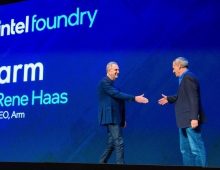
ARM Releases Mali GPU For Smartphones And TVs
ARM today introduced the ARM Mali-T604 Graphics Processing Unit (GPU) at the ARM Technology Conference 2010 in Santa Clara,
boasting a fivefold performance improvement over existing chips for smartphones, digital set-top boxes and in-car entertainment devices.
The Mali-T604 is currently available to license. Samsung, who is already a licensee of the Mali graphic processor technology, will be the first ARM Partner who can gain access to the Mali-T604.
"Visual computing is driving the next generation of consumer electronics, as consumers and developers demand the highest levels of graphics performance," said Lance Howarth, EVP and general manager, Media Processing Division, ARM. "The tri-pipe architecture in the Mali-T604 provides both market leading compute functionality and high-performance graphics without compromise, enabling unequalled user experiences in energy-efficient consumer electronic devices."
ARM?s fourth-generation GPU is specifically designed to meet the needs of General Purpose computing on GPU (GPGPU) and extends API support to include full profile Khronos OpenCL and Microsoft DirectX. Support for GPGPU is becoming increasingly important for enhanced Augmented Reality applications and gesture recognition.
The Mali-T604 brings patented techniques reducing memory bandwidth consumption, by up to 30%, substantially improving system level energy-efficiency. The Mali-T604 fully exploits ARM?s Cache Coherent Interconnect (CCI-400) to deliver a memory coherent system with the recently announced ARM Cortex-A15 MPCore.

The Mali GPU family scales from the smallest GPU in the world through to scalable multicore solutions for high frame-rate HD devices. It is widely adopted, currently having 31 licensees and ships in a growing range of consumer electronics devices. Building on the heritage of Mali-400 MP, the Mali-T604 is ARM?s fourth-generation GPU and is the first member of a new family of GPUs based on the Midgard architecture which all use a common software driver, minimising software upgrade costs for future implementations. The Mali-T604 delivers up to 5x performance improvement over previous Mali graphics processors and is specifically designed to meet the needs of General Purpose computing on GPU (GPGPU).
The Midgard architecture is ARM?s new architecture for the next generations of our Mali GPU family. Mali-T604 is the first implementation of the Midgard architecture, which is designed to address the demands of the evolving world of graphics and prepared to meet the challenges of using GPUs to solve other types of computational problems.

ARM's new shader core is the heart of the new GPU and it's really cool. Based on a radical "tri-pipe" architecture using three different types of execution pipeline within the shader core, it simultaneously addresses the demands of evolving high-performance graphics and GPU computing without compromising graphics performance or efficiency. The tri-pipe architecture delivers higher levels of performance through parallelising the issue of instructions to do the three main parts of graphics and GPU computing.
The arithmetic pipeline supports full IEEE-754-2008 and has a wide range of data types from FP16, through FP32 to double-precision FP64 and all the integer types. OpenCL efficiency and performance is assured with a large number of the Built-In Function Library routines supported directly as instructions. The texture pipeline supports all the new texture formats needed for the new APIs and both it and the load/store/varyings pipeline have new features to reduce energy consumption and increase throughput in real-world memory systems.
"Visual computing is driving the next generation of consumer electronics, as consumers and developers demand the highest levels of graphics performance," said Lance Howarth, EVP and general manager, Media Processing Division, ARM. "The tri-pipe architecture in the Mali-T604 provides both market leading compute functionality and high-performance graphics without compromise, enabling unequalled user experiences in energy-efficient consumer electronic devices."
ARM?s fourth-generation GPU is specifically designed to meet the needs of General Purpose computing on GPU (GPGPU) and extends API support to include full profile Khronos OpenCL and Microsoft DirectX. Support for GPGPU is becoming increasingly important for enhanced Augmented Reality applications and gesture recognition.
The Mali-T604 brings patented techniques reducing memory bandwidth consumption, by up to 30%, substantially improving system level energy-efficiency. The Mali-T604 fully exploits ARM?s Cache Coherent Interconnect (CCI-400) to deliver a memory coherent system with the recently announced ARM Cortex-A15 MPCore.

The Mali GPU family scales from the smallest GPU in the world through to scalable multicore solutions for high frame-rate HD devices. It is widely adopted, currently having 31 licensees and ships in a growing range of consumer electronics devices. Building on the heritage of Mali-400 MP, the Mali-T604 is ARM?s fourth-generation GPU and is the first member of a new family of GPUs based on the Midgard architecture which all use a common software driver, minimising software upgrade costs for future implementations. The Mali-T604 delivers up to 5x performance improvement over previous Mali graphics processors and is specifically designed to meet the needs of General Purpose computing on GPU (GPGPU).
The Midgard architecture is ARM?s new architecture for the next generations of our Mali GPU family. Mali-T604 is the first implementation of the Midgard architecture, which is designed to address the demands of the evolving world of graphics and prepared to meet the challenges of using GPUs to solve other types of computational problems.

ARM's new shader core is the heart of the new GPU and it's really cool. Based on a radical "tri-pipe" architecture using three different types of execution pipeline within the shader core, it simultaneously addresses the demands of evolving high-performance graphics and GPU computing without compromising graphics performance or efficiency. The tri-pipe architecture delivers higher levels of performance through parallelising the issue of instructions to do the three main parts of graphics and GPU computing.
The arithmetic pipeline supports full IEEE-754-2008 and has a wide range of data types from FP16, through FP32 to double-precision FP64 and all the integer types. OpenCL efficiency and performance is assured with a large number of the Built-In Function Library routines supported directly as instructions. The texture pipeline supports all the new texture formats needed for the new APIs and both it and the load/store/varyings pipeline have new features to reduce energy consumption and increase throughput in real-world memory systems.





















